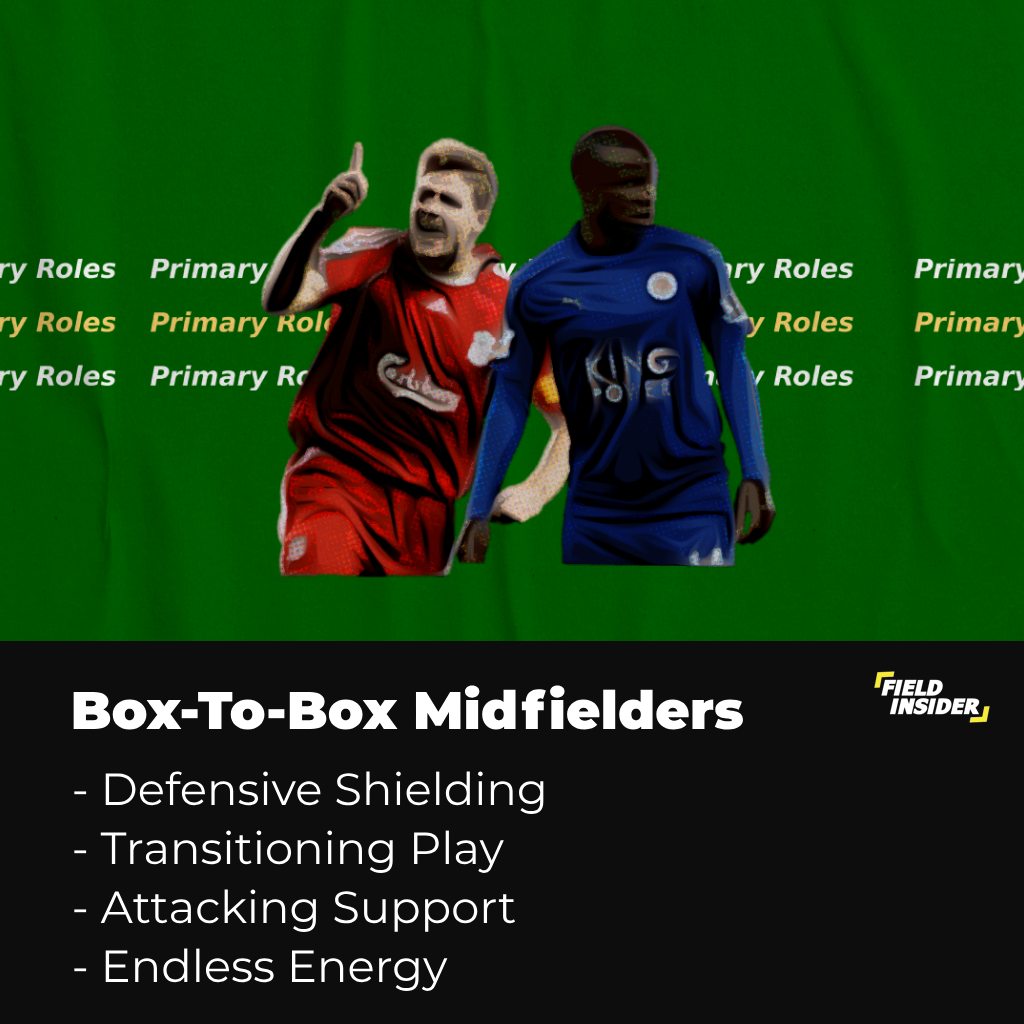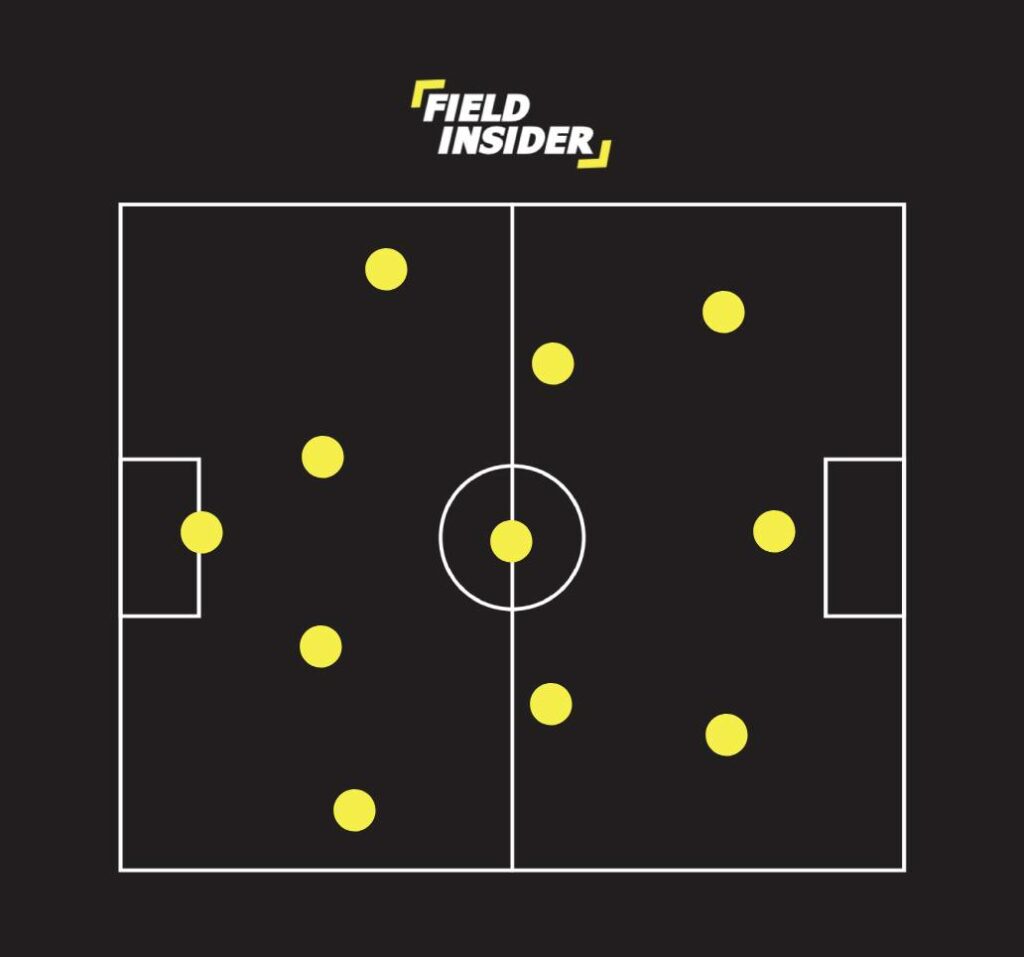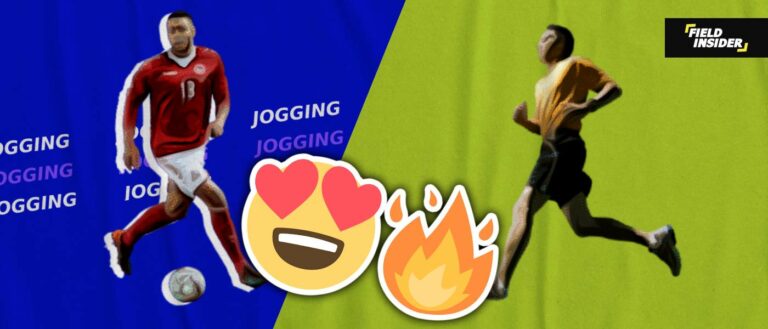Box-To-Box Midfielder vs Roaming Playmaker
In the vibrant world of soccer, the battle for midfield supremacy stands as a captivating saga of strategy, skill, and stamina. Central to this are two pivotal roles: the box-to-box midfielder and the roaming playmaker. Each carries unique responsibilities, traits, and impacts, shaping the flow and outcome of games.
This article aims to dissect these roles, providing clarity and insight into their distinct characteristics and their roles within team dynamics. By delving into the nuances of each position, we can appreciate the complexity and beauty of soccer tactics and how they influence the flow and outcome of the game.
key takeaways
| Topic | Key Takeaways |
|---|---|
| What is a Box-To-Box Roaming Midfielder? | Creative, dictates play, high tactical intelligence. |
| What is a Box-To-Box Midfielder? | Dynamic, covers both defense and attack, high stamina. |
| Primary Roles | Box-to-Box: Link defense to attack. Roaming: Create and dictate play. |
| Key Differences | Box-to-Box: Physical and versatile. Roaming: Creative and strategic. |
| Similarities | Both crucial for midfield dynamism, tactical intelligence. |
| Typical Formation Fit | Box-to-Box: Fits in energetic setups like 4-3-3. Roaming: Thrives in strategic setups like 4-2-3-1. |
| The Debate: Which Is More Crucial? | Depends on team strategy and formation. No definitive answer. |
What is a Roaming Playmaker?
The roaming playmaker stands as the creative heart of a soccer team, often dictating the pace and direction of the game. This role is characterized by exceptional vision, technical skills, and the freedom to move across the pitch.
Roaming playmakers are the architects behind the most ingenious plays, demonstrating a unique blend of creativity and strategic thinking.
Defining Characteristics
Roaming playmakers are distinguished by their superior ball control, vision, and passing ability. They possess the unique ability to change the course of a game with a single pass.
These players thrive on freedom, roaming the field to find space and create opportunities. Their intelligence, both in movement and decision-making, sets them apart from other roles on the pitch.
Tactical Responsibilities
The tactical responsibilities of a roaming playmaker are centered around creativity and orchestration of play. They are tasked with finding gaps in the defense, delivering precise passes, and setting the rhythm of the game.
While not primarily defensive, they contribute by initiating high presses and quick turnovers. Their movement off the ball is just as critical, constantly repositioning to provide an outlet for teammates and to disorient the opposition.
Notable Examples in Modern Football
The world of modern football boasts several outstanding roaming playmakers who have captivated fans with their skill and intelligence. Players like Kevin De Bruyne , Andrea Pirlo and Luka Modric exemplify the essence of this role, demonstrating an ability to control the midfield with their strategic insights and offensive prowess.

Their careers offer invaluable lessons on the impact a skilled playmaker can have on the overall team performance.
What is a Box-To-Box Midfielder?
The box-to-box midfielder is a dynamic force in soccer, integral to both defensive and offensive play. They embody endurance, versatility, and an unparalleled work rate, connecting the defense with the attack.
This role is crucial in modern football, demanding a unique blend of physical stamina and tactical intelligence.
Defining Characteristics
The defining characteristics of a box-to-box midfielder include remarkable stamina, tactical versatility, and the ability to perform under pressure. These players are known for their ability to cover every inch of the field, contributing to both defense and attack.
Their physical fitness is unparalleled, enabling them to maintain a high level of performance throughout the match.
Tactical Responsibilities
A box-to-box midfielder’s tactical responsibilities are vast and varied. Defensively, they break up opposition attacks and protect the backline. In transition, they are the pivotal link between defense and attack, often driving the ball forward with energy and purpose.
Offensively, they support the forwards, contributing with key passes and even goals, embodying the team’s tactical flexibility and adaptability.
Notable Examples in Modern Football
Modern football has seen many exemplary box-to-box midfielders who have left a significant mark on the game. Players like N’Golo Kanté, Steven Gerrard and Arturo Vidal have redefined the role with their tireless running, exceptional ball recovery, and ability to contribute to team attacks.
Their performances illustrate the profound impact a top-tier box-to-box midfielder can have on a team’s dynamics and success.
Primary Roles of roaming and Box-to-Box Midfielders
Box-to-box and roaming midfielders are fundamental components of a soccer team’s core, each bringing distinctive qualities to the midfield. While their responsibilities may overlap, the primary roles they play on the field highlight the diverse strategies employed in modern soccer.
Roaming Midfielder: The Creative Conductor
Creative Playmaking: The roaming midfielder’s primary role is to serve as the team’s creative hub. They are tasked with orchestrating the attack, utilizing their vision and passing abilities to create scoring opportunities for their teammates.
Their creativity and intelligence on the ball make them the focal point of the team’s offensive play.
Movement and Positioning: Unlike more static midfield roles, roaming midfielders are characterized by their freedom to move across the field. This mobility allows them to find space and exploit gaps in the opposition’s defense.
Their unpredictable movement patterns make them difficult to mark and essential in unlocking tight defenses.
Defensive Contribution: While not their primary focus, roaming midfielders also contribute to the team’s defensive efforts. They apply pressure on the opposing midfielders, disrupt the opposition’s rhythm, and help in regaining possession.
However, their defensive duties are usually less demanding than those of a box-to-box midfielder, allowing them to conserve energy for creative tasks.
Box-to-Box Midfielder: The Dynamic Engine

End-to-End Involvement: The primary role of a box-to-box midfielder is characterized by their ability to operate effectively across the entire length of the pitch. Their tireless running enables them to contribute to both defensive duties and attacking plays, embodying the team’s dynamism and physicality.
Transitional Link: Box-to-box midfielders serve as the essential link between defense and attack. They excel in transitioning the ball quickly, breaking up opposition plays, and then driving forward to support offensive moves.
Their energy and stamina are crucial in fast-paced counter-attacks and defensive recoveries.
Versatility and Adaptability: A hallmark of the box-to-box midfielder is their versatility. They are adaptable, capable of performing a variety of roles depending on the game’s demands.
Whether it’s filling in defensive gaps, supporting the attack, or maintaining midfield balance, their all-around gameplay is vital to the team’s structure.
Key Differences
| Aspect | Box-to-Box Midfielder | Roaming Midfielder |
|---|---|---|
| Primary Function | Link defense and attack, versatile. | Create plays, focus on attacking phase. |
| Typical Area of Play | Covers entire pitch, defense to attack. | Focuses mainly on midfield to attacking third. |
| Defensive Responsibilities | Significant, involved in tackles and interceptions. | Less defensive, focuses more on positioning. |
| Energy and Stamina | High, must maintain intensity throughout the game. | Moderate, with emphasis on creative bursts. |
| Typical Tactical Formation | Thrives in 4-4-2 or 3-4-3. | Fits well in 4-2-3-1 or 4-3-3. |
| Key Attributes | Endurance, versatility, tackling. | Creativity, vision, passing accuracy. |
Similarities Between Box-To-Box and Roaming Midfielders
Despite the clear differences, box-to-box and roaming midfielders share several key similarities, underscoring their integral roles within the team’s midfield dynamics.
Versatility and Adaptability
Both box-to-box and roaming midfielders are celebrated for their versatility and adaptability on the field. They must adjust their playing style based on the flow of the game, the tactics of their opponents, and the strategic needs of their team.
This adaptability makes them invaluable, as they can influence the game in multiple areas, be it defense, midfield, or attack.
Tactical Intelligence
Tactical intelligence is another critical commonality. Both roles require a deep understanding of the game, an ability to read play developments, and the foresight to anticipate opponents’ moves.
Box-to-box and roaming midfielders must make quick decisions, positioning themselves effectively to either defend against attacks or create offensive opportunities for their team.
Work Rate and Stamina
A high work rate and exceptional stamina are indispensable qualities for both roles. Box-to-box midfielders are renowned for their relentless energy, moving up and down the field to support both defensive and offensive plays.
Similarly, roaming midfielders, while perhaps not covering the same extensive ground defensively, require significant stamina to maintain their creative efforts, position themselves strategically, and exploit spaces throughout the entire match.
Contribution to Team Dynamics
Both types of midfielders contribute significantly to the team’s dynamics. Box-to-box midfielders provide a bridge between defense and attack, offering balance and support wherever it’s needed.
Roaming midfielders, while focusing more on creation and distribution, also contribute to balancing the team by ensuring offensive fluidity and cohesion. Their roles are pivotal in transitioning the ball, maintaining possession, and dictating the pace of the game.
Importance in Transition Play
Transition play is an area where both box-to-box and roaming midfielders shine. They play crucial roles in shifting the team from defense to attack and vice versa.
Box-to-box midfielders often drive the ball forward themselves, while roaming midfielders use their vision to distribute the ball effectively during transitions, ensuring that the team can quickly switch between phases of play.
Skill Ratings of Box-To-Box Midfielders
The detailed bar chart presents the skill ratings of premier box-to-box midfielders, as evaluated by the model of FootballTransfers.

Leading the pack is Martin Ødegaard with a stellar rating of 87.0, reflecting his exemplary endurance and skill, which are crucial for the demanding nature of a box-to-box midfielder. Close behind, Granit Xhaka’s 84.8 showcases his exceptional balance between defensive might and offensive capability.
Ilkay Gündoğan and Jamal Musiala, each with a rating of 83.8, exemplify the blend of resilience, tactical awareness, and transitional play central to FootballTransfers’ evaluations. Their contributions on both ends of the pitch highlight the dynamic versatility required in modern football.
Rounding off the list, Thomas Müller’s rating of 82.6 underlines his robust stamina and intelligent playmaking, traits that are vital according to the FootballTransfers model.
This chart, underlines the diverse attributes needed to excel as a box-to-box midfielder. It reflects not only on the players’ individual capabilities but also on the critical features that are essential for success in this multifunctional role.
Typical Formation Fit for Roaming and Box-to-Box Midfielders
The tactical alignment within a soccer team significantly influences the roles and effectiveness of different types of midfielders. Roaming and box-to-box midfielders fit distinctively into various formations, each enhancing the team’s structure and strategy in unique ways.
Typical Formation Fit for Roaming Midfielders
4-2-3-1 Formation
In the 4-2-3-1 formation, the roaming midfielder typically occupies the central role in the attacking midfield trio. This position is ideal as it allows them to drift across the pitch, find pockets of space, and connect with both wingers and the striker.
3-5-2 Formation
The 3-5-2 formation provides a central role for the roaming midfielder, positioned between the defense and the attack. This setup allows them to drop back into their own half to collect the ball, turn, and drive forward, or move into more advanced positions to support the strikers.
4-3-3 Formation
While traditionally associated with wingers and a static midfield trio, the 4-3-3 formation can be adapted to accommodate a roaming midfielder. In this modified setup, the roaming midfielder plays as part of the midfield trio but with the license to push forward and create.

Box-to-Box Midfielder: The Dynamic Force in Fluid Formations
4-4-2 Formation
In the traditional 4-4-2 formation, the box-to-box midfielder partners with a more defensively minded midfielder in the center. They are the engine of the team, responsible for covering ground, supporting both defense and attack, and adding energy to the midfield battle.
3-4-3 Formation
Within a 3-4-3 formation, the box-to-box midfielder operates in the central pair of the midfield four. Their role is to ensure defensive solidity while also providing thrust and support to the attacking trio ahead, making them essential to both the defensive structure and the offensive strategy.
5-3-2 Formation
In a more defensive 5-3-2 setup, the box-to-box midfielder is crucial in adding dynamism to the team’s play. They bridge the gap between a solid backline and the forward players, contributing significantly to transitions and ensuring the team remains competitive in midfield skirmishes.
The Debate: Which Is More Crucial?
The roles of roaming and box-to-box midfielders are crucial to any soccer team’s success, each bringing distinct strengths to the pitch. However, the debate over which type is more essential remains a topic of intense discussion among fans, coaches, and pundits alike.

Team Systems and Strategies
The significance of a roaming vs. box-to-box midfielder often depends on the team’s overarching systems and strategies. A 4-3-3 formation, for instance, might favor the dynamism of a box-to-box midfielder to maintain balance between attack and defense.
Conversely, a 4-2-3-1 formation could highlight the importance of a roaming midfielder’s creativity and ability to unlock defenses. Teams need to consider their tactical approach and the specific demands of their chosen formation when deciding which midfielder type is more crucial.
Impact on Match Dynamics
The impact on match dynamics can also sway the debate. Box-to-box midfielders, with their tireless work rate and defensive contributions, can be indispensable in tightly contested matches where control and physicality are paramount.
On the other hand, roaming midfielders can change the course of a game with their creative insights and passing ability, especially when breaking down defensive opponents.
The Case for Hybrid Roles
Modern football has seen the emergence of hybrid roles, blending the characteristics of both roaming and box-to-box midfielders. Players are increasingly required to exhibit versatility, combining the physical endurance and defensive prowess of a box-to-box midfielder with the creativity and attacking flair of a roaming playmaker.
This evolution suggests that the debate might not be about choosing one over the other but rather about valuing players who can embody both roles to varying degrees.
conclusion
In conclusion, the distinctions and similarities between box-to-box midfielders and roaming playmakers underscore the strategic depth and diversity within soccer. Each role, characterized by unique skill sets and tactical responsibilities, contributes significantly to the team’s overall dynamics and success.
The choice between these roles is not about which is more crucial universally but rather which best complements a team’s specific tactical setup. As soccer continues to evolve, understanding these roles becomes increasingly important for teams striving for tactical flexibility and dominance on the field.











